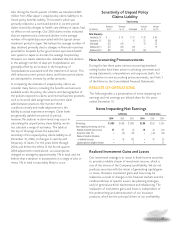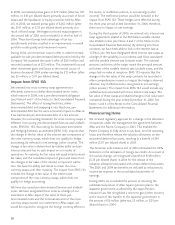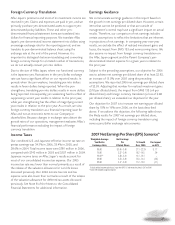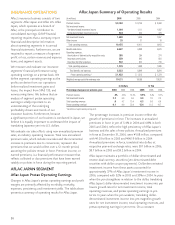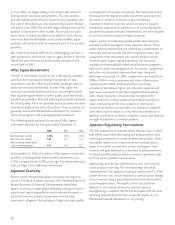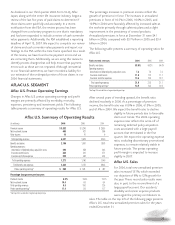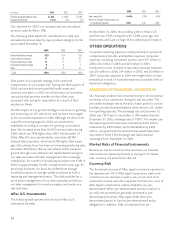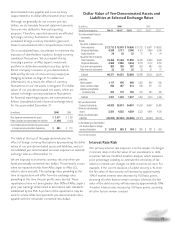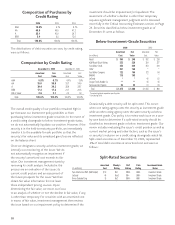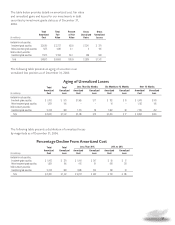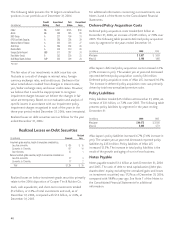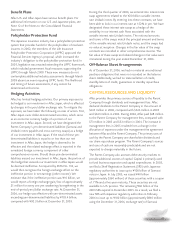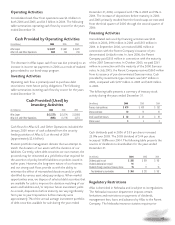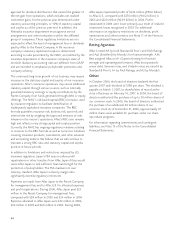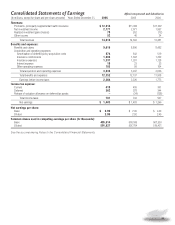Aflac 2006 Annual Report Download - page 41
Download and view the complete annual report
Please find page 41 of the 2006 Aflac annual report below. You can navigate through the pages in the report by either clicking on the pages listed below, or by using the keyword search tool below to find specific information within the annual report.
37
The following table details investment securities by segment
as of December 31.
We have investments in both publicly issued and privately
issued securities. However, the status of issuance should not
be viewed as an indicator of liquidity or as a limitation on the
determination of fair value. The outstanding amount(s) of a
particular issuance, as well as the level of activity in a particular
issuance and the state of the market, including credit events
and the interest rate environment, affect liquidity regardless of
type of issuance. We routinely assess the fair value of all of our
investments. This process includes evaluating quotations
provided by outside securities pricing sources and/or
compiled using data provided by external debt and equity
market sources, as described more fully in Note 3 of the
Notes to the Consolidated Financial Statements. The following
table details investment securities by type of issuance as of
December 31.
Privately issued securities accounted for 68.8% of total debt
securities, at amortized cost, at December 31, 2006, compared
with 66.6% at December 31, 2005. Privately issued securities
held by Aflac Japan at amortized cost accounted for $31.3
billion, or 64.0%, of total debt securities at December 31,
2006, and $27.9 billion, or 61.8%, of total debt securities at
December 31, 2005. Reverse-dual currency debt securities
accounted for $9.7 billion, or 28.9%, of total privately issued
securities at December 31, 2006, compared with $8.9 billion,
or 29.6%, of total privately issued securities at December 31,
2005. Aflac Japan has invested in privately issued securities to
secure higher yields than those available from Japanese
government bonds. Aflac Japan’s investments in yen-
denominated privately issued securities consist primarily of
non-Japanese issuers and have longer maturities, thereby
allowing us to improve our asset/liability matching and our
overall investment returns. Most of our privately issued
securities are issued under medium-term note programs and
have standard documentation commensurate with credit
ratings, except when internal credit analysis indicates that
additional protective and/or event-risk covenants are
required.
Our investment activities expose us to credit risk, which is a
consequence of extending credit and/or carrying investment
positions. However, we continue to adhere to prudent
standards for credit quality. We accomplish this by considering
our product needs and overall corporate objectives, in
addition to credit risk. Our investment policy requires that all
securities be rated investment grade at the time of purchase.
In evaluating the initial rating, we look at the overall senior
issuer rating, the explicit rating for the actual issue or the
rating for the security class, and, where applicable, the
appropriate designation from the Securities Valuation Office
(SVO) of the National Association of Insurance
Commissioners (NAIC). All of our securities have ratings from
either a nationally recognized statistical rating organization or
the SVO of the NAIC. In addition, we perform extensive
internal credit reviews to ensure that we are consistent in
applying rating criteria for all of our securities.
We use specific criteria to judge the credit quality of both
existing and prospective investments. Furthermore, we use
several methods to monitor these criteria, including credit
rating services and internal credit analysis. The distributions by
credit rating of our purchases of debt securities for the years
ended December 31, based on acquisition cost, were as
follows in the table on the next page:
Investment Securities by Segment
Aflac Japan Aflac U.S.
(In millions) 2006 2005 2006 2005
Securities available for sale,
at fair value:
Fixed maturities $ 22,044 $ 21,907 $ 6,659* $ 6,134*
Perpetual debentures 3,935 3,888 473 482
Equity securities 25 61 –23
Total available for sale 26,004 25,856 7,132 6,639
Securities held to maturity,
at amortized cost:
Fixed maturities 13,464 10,849 19 18
Perpetual debentures 3,990 4,172 ––
Total held to maturity 17,454 15,021 19 18
Total investment securities $ 43,458 $ 40,877 $ 7,151 $ 6,657
*Excludes investment-grade fixed-maturity securities held by the Parent Company of $102 in 2006 and $100 in
2005.
Investment Securities by Type of Issuance
2006 2005
Amortized Fair Amortized Fair
(In millions) Cost Value Cost Value
Publicly issued securities:
Fixed maturities $ 15,092 $ 16,269 $ 14,872 $ 16,540
Perpetual debentures 173 176 173 180
Equity securities 13 22 14 51
Total publicly issued 15,278 16,467 15,059 16,771
Privately issued securities:
Fixed maturities 25,490 25,905 21,855 22,441
Perpetual debentures 8,158 8,256 8,254 8,442
Equity securities 3316 33
Total privately issued 33,651 34,164 30,125 30,916
Total investment securities $ 48,929 $ 50,631 $ 45,184 $ 47,687


